| Francis II, Dauphin of France | Henry Stuart, Lord Darnley | James Hepburn, Lord Bothwell |
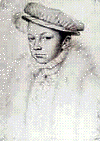 |
||
| Francis II, born 19th January 1544, King
of France, was the oldest son of Henry II and Catherine de Médicis. Francis married Mary,
Queen of Scots on 24th April 1558. After succeeding to the throne in 1559 Francis came under
the influence of Mary's powerful Guise relatives who sought to destroy the French
Protestants or Huguenots. The ensuing persecution provoked the Huguenot Conspiracy of Amboise (1560),
a plot to abduct Francis and arrest his Guise mentors. The plan was
discovered and the incipient rebellion bloodily crushed, but Francis's death curtailed
Guise influence.
Mary was but a girl of 15 when she married Francis with whom she had been brought up. Francis, a year younger, adored Mary and she bore him a strong sisterly affection. He was a weak and sickly child, and it is unlikely that the marriage was ever consummated. Francis fell ill with an ear infection in November 1560 and was dead by 5th December, just over two and a half years after their union. |
||
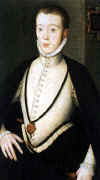 |
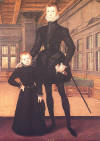 |
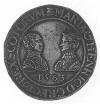 |
| Henry Stuart, Lord Darnley, born 7th December 1545 at Temple Newsham in Yorkshire, was the second husband of Mary, Queen of Scots. The second son of Matthew, 4th Earl of Lennox and Lady Margaret
Douglas, who was the daughter of Margaret Tudor (sister of Henry VIII) with her second husband,
Archibald, 6th Earl of Angus. Darnley's father had originally hoped to marry Mary of Guise (Mary, Queen of Scots' mother) whom he had been sent by the French king to help against the English, but had subsequently
changed his loyalties when the marriage was not forthcoming, and sworn allegiance to Henry
VIII in exchange for his niece's hand. Darnley's mother had been the pawn in the bitter dispute
between her own mother and father, and the victim of her paranoid uncle Henry. She had been a model
of diplomacy at the English court where her mother had left her, juggling the favours of Henry's
successive wives, while keeping her own head on her shoulders. After having been imprisoned for falling
in love without her uncle's permission and seeing her lover die in jail, she was unexpectedly restored
to Henry's good books and allowed to marry a man who, though not her soul mate, was nevertheless handsome and promising enough. Their first child, also named Henry Stuart, died shortly after birth and in their second
child, both parents poured all their dreams and ambitions. Darnley's father aspired to the Crown of Scotland, as
he was descended from James II through the marriage of his grand-father (Matthew Stewart, the 2nd Earl
of Lennox) to James's grand-daughter, Elizabeth, a claim which his rival, James Hamilton 2nd Earl of Arran, would
contradict time and time again, as his father (James Hamilton 1st Earl of Arran) was Elizabeth's brother.
Darnley's mother, besides being Henry VIII's niece, was also half-sister to James V of Scotland through her mother's first marriage to James IV. Imprisoned by her uncle, then promised the Crown of England for her heir, a promise promptly broken by Henry's will, Margaret's hopes soared again when Mary Tudor, her lifelong friend, took
over after the death of Henry's son, Edward VI. Mary I however, while showing great generosity to Darnley and
his parents, wanted her own heir to inherit the English Crown. As Mary I died childless, Darnley's parents
once more coveted a royal future for their son, wishing either the death of Mary's half-sister Elizabeth Tudor, or
that of Mary, Queen of Scots' French husband, Francis II over the water. As it happened, it was the latter plan
which came to fruition.
Darnley met Mary twice before becoming her suitor. He was sent clandestinely to France by his parents in 1559 after the death of Mary's father-in-law, Henry II. He spent some time at Chambord where the French court was at that moment, under the protective wing of his paternal uncle John Stuart d'Aubigny, who had remained in France. Darnley was not yet thirteen and carried with him a letter from his father, in which he pleaded to have his forfeited Scottish estates restored. This was nothing but a formal audience with Mary, but a subtle way of introducing young Darnley on the scene. In 1560, when Francis II died in his turn leaving Mary a widow, Darnley was once more sent over to offer his parents' condolences. There is no evidence that Mary regarded Darnley as a suitable choice for a new husband at that point, and her attentions were directed towards Don Carlos of Spain. Meanwhile, Elizabeth I who had always regarded the Lennoxes with extreme suspicion, found out that they had been sending their son abroad behind her back and had them arrested. Darnley though, managed to slip away to France where he stayed for about a year. However, the tide soon turned again in the Lennoxes' favour. Elizabeth who had almost died of smallpox was faced with the thorny issue of her succession and preferred the claim of the Lennoxes for their son, rather than that of the Suffolk line, the spectre of the Grey family (grand-daughter of Elizabeth's aunt, Mary, the other sister of Henry VIII). Margaret and Matthew were released and Darnley returned to England in 1563, while Lennox was allowed to travel to Scotland to obtain the restitution of his estates. Elizabeth's attitude towards Mary's marriage negotiations was ambiguous to the extreme. First she made it plain that she would consider her an enemy of England, should she marry into a foreign power such as Spain. Then, she put forward her favourite Robert Dudley, a man lacking in royal blood, related to convicted criminals, suspected of his wife's death and rumoured to be Elizabeth's lover. It is clear that she never expected Mary to accept her choice of husband for her, and negotiations were brought to an end when Elizabeth refused to name Mary as her successor in exchange. However, at the same time, she allowed Darnley to join his father in Scotland for "legal matters". On 17th February 1565, Darnley arrived at Wemyss Castle in Fife, where he met up with Mary for the third time. Did Mary fall in love with Darnley or was it just a political match which backfired? The question has been much debated in favour of one or the other theory, and here again, the truth probably lies somewhere in between. As a matter of fact, Darnley and Mary had an awful lot in common. Not only were they both considered extremely attractive people, young and unusually tall for the era (both were over 6 feet tall), but they had received the same education and shared the same taste in many areas. Darnley was an accomplished dancer and sportsman, could play the lute, converse with Mary in her native Scot as well as in her preferred French, understand Latin and write verses. His ambitious parents had taken care to provide him with an education fit for a king in the making. Furthermore, Darnley and Mary both shared a claim to the English throne as well as a common Scottish ancestor. Throughout their childhood and adolescence they had been both doted on, pampered and praised, one leading a sheltered existence at the French court and the other at his parents' home in Yorkshire. The only romantic attachment Mary had known so far was with a sickly immature boy of 15 for whom she had had no more than sisterly affection. His untimely death had robbed them of the possibility of turning this relationship into a marital one, and since then, Mary had only considered marriage in the context of a political exercise. What must this 24 year old full of life and health have thought when she found herself suddenly wooed by this good-looking, cultured peer who benefited from being an English subject and having strong royal connections of his own? Undeniably, she must have welcomed the opportunity of solving the problem of her marital status by marrying a man she felt attracted to, a rare thing for a Queen in those days. At first Mary did seem to take offence to Darnley's early proposal of marriage, but soon after Elizabeth's refusal to pronounce herself on her succession until she had made up her mind about getting married herself, there was no stopping Mary from wedding Darnley. She wrote impulsive letters in which she asked for Elizabeth's permission to marry Darnley, and then subsequently told her that she would marry him with or without her consent. This latter letter was intercepted by Mary's Secretary, Maitland of Lethington out of diplomatic concerns, which caused a breach in their relationship. Darnley had lost the favour of the Earl of Moray by asserting that he owned too many estates, and his violent outbursts were cracking the veneer of his persona. Darnley had been confined to his bed due to an unusually long spell of the measles, which in view of his later illness, tends to suggest that he may have already suffered from the first signs of syphilis. Mary, blind to this personality change, spent long hours at his bedside in the intimacy of his private chamber. By May 1565, Darnley had made a full recovery. Darnley and Mary were married in a short Catholic ceremony on 29th July 1565. However, the contractual part of the marriage was probably completed in secret on 9th of the same month. Mary did not wait for the papal dispensation necessary for their marriage as they were related, and when it did arrive, it was luckily backdated so as to validate their union. Mary thus married Darnley hurriedly, bestowing titles upon him and issuing a coin in his honour, building up a group of supporters in the face of mounting opposition from Moray's party, and ignoring Elizabeth's orders. If she had hesitated before, Mary had now made it clear that she was not prepared to be dictated to as to her choice of husband; not by her advisers and relatives, nor by another monarch, nor indeed by the Church itself. However, by the time the Earl of Moray and his accomplices had fled to England in October 1565 following the crush of their rebellion against Mary, known as the "Chaseabout Raid", the mood had changed. Mary, who had elevated Darnley to virtual King status before they were even married, and conferred upon him more authority than she may have had the right to, began to realise Darnley's true nature. If she had loved him, she now perceived that the feeling was not returned and that she was just the stepping stone to his own advancement. The Crown Matrimonial, which would have allowed Darnley to rule in Scotland should Mary have died childless, was his most cherished goal. In response to Mary curbing his authority or to any offence made to him, Darnley sulked disappearing for days on end either gallivanting throughout Scotland or frequenting establishments of ill-repute in Edinburgh with a bunch of equally dissolute youths. He did so little to partake in state affairs that a special seal bearing his signature was made to allow the ratifying of legal documents in his absence. Her marriage to Darnley resulted in a loss of support for Mary, and Parliament attendance was at an all time low. The Lennox-Hamilton feud was intense, and without the advice of the exiled Lords, Mary now turned to the Earl of Bothwell, whom she had recalled from exile at the time of the Chaseabout Raid, in view of his deep-rooted hatred of the Earl of Moray. By her side too, was the ill-fated David Riccio, Mary's Secretary. When Mary fell ill in the autumn of 1565, Darnley was not at her bedside like she had been at his. In early December, Mary journeyed to Linlithgow in a litter. There, she met Darnley and broke what must have been very bad news to him: Mary was pregnant with their child. The birth of this child effectively robbed him of the opportunity of being King himself. Until then, Darnley's bad behaviour had been limited to frequent drunkenness and inciting others to excessive drinking, neglect of his duties as the Queen's consort, abusive treatment of Mary and reported sexual perversion. The extent of Darnley's cruel nature though was just about to reveal itself with the murder of Rizzio at Holyroodhouse. This event says a lot not only about Darnley's character but also about the general morality of the Scottish nobility of the time. Understandably, Mary had been keeping Darnley at arm's length, having realised what a mistake she had made in marrying him. She had infuriated him by partly pardoning the Duke of Châtelherault (his rival Hamilton) for his role in the Chaseabout Raid, and by placing too much trust and attention in her Secretary, the Italian David Rizzio, whom Darnley had liked at first. The rest of the exiled nobles were getting impatient in England and did not think much of the way the tide seemed to be turning in favour of the catholics again. Mary remained unapproachable but Darnley on the other hand was an easy target. His greed for the Crown Matrimonial which Mary kept refusing him and the deterioration of their relationship was a fertile ground for planting the seed of discord. And so it came about that the nobles who had disapproved of Darnley's marriage to Mary, and rebelled against them, now signed a bond in which they pledged to help Darnley in obtaining the Crown Matrimonial in exchange for his protection. A suggestion that David Rizzio had stepped into his shoes whispered in Darnley's ear was all it took to win him to their side. But the level of cruelty inflicted on David and the way it was done was due to Darnley alone. Darnley insisted that David Rizzio be stabbed in the presence of the Queen, in the hope that she would miscarry. As it happened, Mary did not miscarry and Darnley's plot failed. To read Lord Ruthven's account of the murder of Rizzio, click here. Darnley did not stab Rizzio himself and the bond made no mention of the murder, but his culpability was no less certain. He held Mary down while the crime was being committed and his dagger was left in Rizzio's body. Mary became a prisoner in her own home and Darnley, intimidated by the Lords began to lose his nerve and to plead with Mary, confessing that he had allowed them to return to Scotland to help him obtain the Crown Matrimonial, but maintaining that he had no idea that they intended to kill Rizzio. Mary then cleverly turned the situation to her advantage and with Darnley's cooperation, managed to escape to Dunbar where Bothwell and Huntly were waiting for them. Darnley, relieved to have saved his own skin and believing that Mary had genuinely forgiven him, made a victorious entry into Edinburgh and proclaimed his innocence in the Rizzio murder. On her return to Edinburgh, Mary reluctantly pardoned Moray, Argyll and Glencairn who were reconciliated with her supporters Bothwell, Huntly and Atholl. Morton, George Douglas, Ker of Fawdonside and Ruthven fled into exile in England but made sure that they sent Mary the bond in which Darnley had fully incriminated himself. There was no going back for Darnley at this point. Mary kept a semblance of normality with Darnley to ensure that he would not prejudice her son's future by not acknowledging him as his son. However, as soon as James was born and that Darnley had made no attempt to deny his paternity, Mary shut him out again by devoting herself to her son. Darnley reverted to what he did best, drinking to excess, frequenting prostitutes, making a show of Mary and absenting himself for days on end. He was even known to swim on his own in the sea and lochs, a form of exercise which was not practised in those days, unless to escape death by drowning. But Darnley was once again about to seal his own fate by playing with fire. His self-inflicted isolation led him to seek his father's understanding, and plotting to regain his lost prestige. Spies in his household reported that his plans included seizing his son and ruling in his place as Regent, or a rebellion supported by England. Letters sent to the major Catholic powers and the Pope show how he was trying to discredit Mary by throwing doubt on her faith. Darnley had become a real problem, and how to solve this problem was the object of the discussion which took place between the Lords coalition and Mary at Craigmillar.Mary, who had been very ill some time before, was recovering at Craigmillar. During an ambiguous conversation which was reported two years after the event, the Lords suggested "removing" Darnley. Mary was concerned about the effect a divorce would have on the legitimacy of her son, but declared that nothing should be done to taint her honour. It is generally deduced from those words that she meant that she knew that the Lords's intention was to assassinate Darnley and that it was fine as long as it could not be traced to her. The most that can be concluded though is that Mary did have foreknowledge of the plot against Darnley. Shortly after, the Lords signed a bond in which they undertook to prevent further harm from being committed by Darnley. On 12 December 1566, James was baptized in a lavish Catholic ceremony at Stirling Castle which Darnley, although on site, did not attend presumably to avoid the humiliation of being ignored by Elizabeth's representatives, who still refused to recognise him as King. On 24 December, Mary pardoned the remainder of the Rizzio murderers (except for Ker of Fawdonside and George Douglas) allowing them to return to Scotland, as part of the bargain struck at Craigmillar. Darnley was not going to hang around to face those he had betrayed and took off to Glasgow to see his father. En route he fell ill and it was assumed that he had been poisoned. A later diagnosis however confirmed that he had small pox, which we now know was the later stages of syphilis. On 9th January 1567, Mary sent her physician to Glasgow to report on Darnley's health. By mid-January, Mary had removed her son from Stirling to the palace of Holyroodhouse, still fearing a plot by Darnley to seize him. The following week she set off for Glasgow to visit Darnley who received her in his sick bed full of repentance for his past behaviour, and pleading that they restore conjugal relations. Mary agreed in principle but on condition that he return to Edinburgh with her. Darnley told her of the rumours he had heard concerning a plot to harm him and refused to be moved to Craigmillar Castle. Mary did not want Darnley at Holyroodhouse for fear of contagion and Darnley, who was still badly disfigured with the disease, did not want to be seen there either. A more salubrious environment was suggested to him, which he accepted. The site in question was the Old Provost's Lodging, south of the Cowgate and just within the city wall. They arrived at Kirk o' Field on the last days of January, and a semblance of the early days of their relationship seems to have revived. Mary furnished the Old Provost's Lodging as comfortably as possible and even stayed in the room below Darnley's a couple of nights. She paid him regular visits entertaining him in the company of some of the Lords, and within a week or so, Darnley was pronounced well enough to leave the following Monday. On the night of 9th February 1567, Mary should have spent the night there but had to return to Holyroodhouse to attend the final rejoicings of her favourite page's wedding. Darnley is reported to have been annoyed at this and Mary gave him her ring until the next day as a token of her commitment to him. In the early hours of the morning, a huge explosion brought the Old Provost's Lodging down. Darnley's body and that of his servant William Taylor were found half-naked in the adjacent orchard, unmarked and lying beside some puzzling objects: a cloak, a dagger, rope and a chair. This incident which terminated the life of Darnley is one of the most intricate unsolved murder mysteries of all times. Although the full blame was thrown on Bothwell as the chief murderer and later Mary as his accomplice, there is no doubt that several groups of conspirators were involved, each playing a role which was semi-occulted from the rest. Those Lords who had signed the Craigmillar Bond (which later conveniently disappeared) most probably instigated the plot which was then discovered by Bothwell. Mary had Darnley's body embalmed and buried in the Abbey of Holyrood in the royal vault of James V. (The most detailed discussion of the murder of Lord Darnley can be found in the book by Major-General R. H. Mahon, "The Tragedy of Kirk o' Field".) |
||
 |
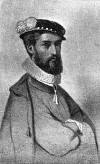 |
|
| James Hepburn, 4th earl of Bothwell, born in 1536, was the third husband
of Mary, Queen of Scots. During the Reformation era James supported the Protestant faction
in Scottish politics. Nonetheless, in 1565 he helped the Roman Catholic Mary put down the
earl of Moray's rebellion. After the murder (which Bothwell probably arranged) of Mary's
second husband, Lord Darnley, at Kirk o' Field, Bothwell made preparations to wed Mary
himself. In what is known as the "Ainslie Tavern Bond", Bothwell secured the
approval of the Protestant Lords to a marriage with Mary. After abducting her
with or without her consent, and allegedly raping her to rob her of any alternative,
Bothwell married Mary on 15th May 1567 by Protestant rites. Soon after, a coalition of
Protestant and Catholic nobles confronted the Queen and Bothwell at Carberry Hill outside
of Edinburgh. Bothwell fled; he died insane on 14th April 1578 in his Danish
prison.
To read a translation of Bothwell's own version of the story, click here. A lot has been said about the relationship between Mary and Bothwell, and although she relied on his influence and power at a time when she was ill, depressed and abandoned by all her advisers, it is not my opinion that Mary ever felt the passion for Bothwell that is often described. The Casket Letters are now commonly accepted to have been forgeries designed to besmirch Mary's character and make her the accomplice of Bothwell in the murder of Darnley. This was done at a time when Moray, Mary's treacherous half-brother, was keen to dissociate himself from the crime and to make sure that Mary would not return to Scotland from her prison in England, and take away the Regency he had coveted for so long. As such, the Casket Letters throw no light on Mary's relationship with Bothwell. The facts though, do. Her marriage to Bothwell was a speedy and squalid affair compared to her previous two weddings. No masques, lavish ceremony and rich presents but a simple meal which everyone ate in silence. On the very day she got married to Bothwell, Mary told Du Croc that she had no desire to be merry, and to Leslie, she announced in floods of tears how much she regretted what she had done, especially her Protestant wedding. The next day, she was heard begging for a knife in front of her equerry Arthur Erskine, so that she may kill herself, and threatened to drown herself instead if he did not do as she wished. Besides Mary's desperate state of mind, Bothwell's attitude towards her was brutal. According to Melville, not a day passed without Mary crying because of the way he treated her. He was jealous, resented her happy nature and forbade her music, hawking and all her other pastimes, and used appalling language in her presence. Although he had had his marriage to Lady Jean Gordon annulled in order to marry Mary, Bothwell seemed to keep the relationship going, assuring Jean that Mary was just his concubine and that she remained his only wife. Further, Bothwell's attitude towards women was notorious, from the blacksmith's daughter, Bessie Crawford who he seduced in a corner of the kitchen, Alison Craik, allegedly Arran's mistress, who he attempted to rape to take revenge on his enemy Arran, the distraught Anna Throndsen who he dumped after promising to marry her, to Janet Beaton, aunt of Mary Beaton one of the four Maries, a woman old enough to be his mother. After Mary saw Bothwell for the last time at Carberry Hill, she does not seem to have made any attempt at contacting him. Neither did she show any interest during her nineteen years of captivity in England. Are these the signs of a wild, passionate romance? |
||
| Francis II, Dauphin of France | Henry Stuart, Lord Darnley | James Hepburn, Lord Bothwell |